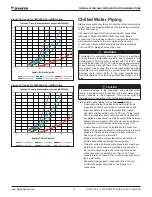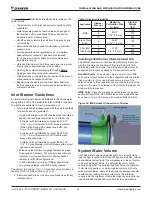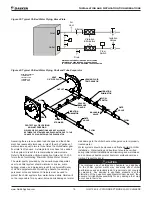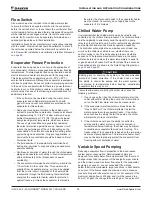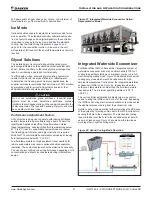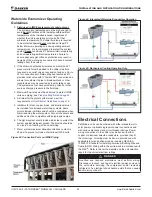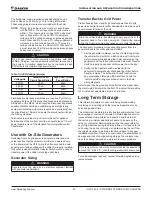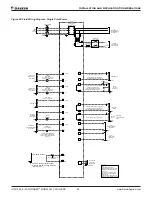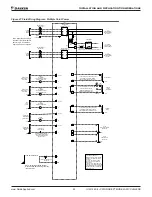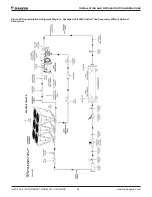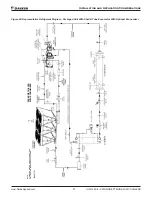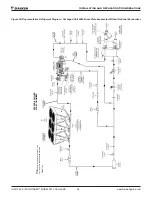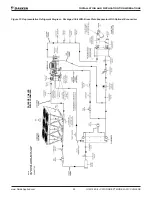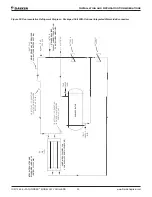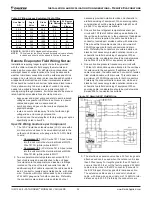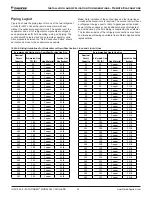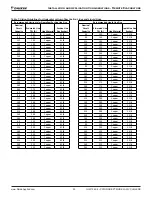
IOM 1242-8 • PATHFINDER
®
MODEL AWV CHILLERS
20 www.DaikinApplied.com
Installation and Application Considerations
Flow Switch
A flow switch must be included in the chilled water system
to prove that there is adequate water flow to the evaporator
before the unit can start, or to shut down the unit if water flow
is interrupted. A factory-included thermal dispersion flow switch
will be installed on packaged models. On remote evaporator
models, the flow switch may be separately field-provided, or
optionally shipped loose for field installation.
Installation should be per manufacturer’s instructions included
with the switch. Flow switches should be calibrated to shut off
the unit when operated below the minimum flow rate for the
unit. Flow switch installation and calibration is further discussed
.
Evaporator Freeze Protection
Evaporator freeze-up can be a concern in the application of
air-cooled water chillers in areas experiencing below freezing
temperatures. To protect against freeze-up, insulation and an
electric immersion heater are furnished with the evaporator.
This helps protect the evaporator down to -20°F (-29°C)
ambient air temperature. Although the evaporator is equipped
with freeze protection, it does not protect water piping external
to the unit or the evaporator itself if there is a power failure or
heater burnout, or if the chiller is unable to control the chilled
water pumps. Use one of the following recommendations for
additional protection:
• If the unit will not be operated during the winter, drain
evaporator and chilled water piping and flush with
glycol. Drain and vent connections are provided on the
evaporator for this purpose.
• Add a year-round glycol solution to the chilled water
system to provide freeze protection. Freeze point should
be approximately 10°F (5.6°C) below minimum design
ambient temperature or 10°F (5.6°C) below the lowest
design leaving water temperature, whichever is lower.
The use of glycol antifreeze is generally considered
the safest protection against freeze-up; however, it will
reduce the performance of the unit, depending on the
concentration. Take this into consideration during initial
system design and selection. On glycol applications, a
minimum fluid concentration should be based on Burst
Protection limits.
•
The field addition of thermostatically controlled heat
tracing and insulation to exposed piping, dependent on
power availability.
• Continuous circulation of water through the chilled water
piping and evaporator, with ability to control temperature
within chiller safety limits. (Dependent on power
availability).
• The evaporator immersion heater is factory-wired to the
115-volt circuit in the control box. This power can be
supplied from a separate source, or it can be supplied
from the control circuit. Operation of the heater cable
is automatic through the fluid sensing thermostat that
energizes the evaporator heater cable for protection
against freeze-up. Unless the evaporator is drained in
the winter, the disconnect switch to the evaporator heater
must be closed. Conversely, do not apply heat to the
evaporator if it is drained.
Chilled Water Pump
It is important that the chilled water pumps be wired to, and
controlled by, the chiller’s microprocessor. The chiller controller
has the capability to selectively send the signal to a pump
relay (by others) to start pump A or B or automatically alternate
pump selection and also has standby operation capability.
The controller will energize the pump whenever at least one
circuit on the chiller is enabled to run, whether there is a
call for cooling or not. This helps ensure proper unit startup
sequence. To help prevent evaporator freeze-up, the pump
will also be turned on when the water temperature is equal to
or goes below the Freeze Set Point for at least three seconds.
Connection points are shown in the Field Wiring Diagrams on
.
CAUTION
Adding glycol or draining the system is the recommended
method of freeze protection. If the chiller does not have
the ability to control the pumps and the water system is
not drained in temperatures below freezing, catastrophic
evaporator failure may occur.
Failure to allow pump control by the chiller may cause the
following problems:
1. If any device other than the chiller attempts to start the
chiller without first starting the pump, the chiller will lock
out on the No Flow alarm and require manual reset.
2. If the evaporator water temperature drops below the
“Freeze Set Point” the chiller will attempt to start the
water pumps to avoid evaporator freeze. If the chiller
does not have the ability to start the pumps, the chiller
will alarm
due to lack of water flow.
3. If the chiller does not have the ability to control the
pumps and the water system is not to be drained in
temperatures below freezing, the chiller may be subject
to catastrophic evaporator failure due to freezing. The
freeze rating of the evaporator is based on the immersion
heater and pump operation. The immersion heater itself
may not be able to properly protect the evaporator from
freezing without circulation of water.
Variable Speed Pumping
Reducing evaporator flow in proportion to load can reduce
system power consumption. Daikin Applied chillers are
designed for variable water flow duty provided that the rate of
change is less than ten percent of the design flow per minute,
and the minimum and maximum flow rates for the evaporator,
beginning on
, are not exceeded. If flow drops
below the minimum allowable, large reductions in heat transfer
can occur. If the flow exceeds the maximum rate, excessive
pressure drop and tube erosion can occur. For example, if the
maximum design flow is 200 gpm and it will be reduced to a
flow of 140 gpm, the change in flow is 60 gpm. Ten percent of












